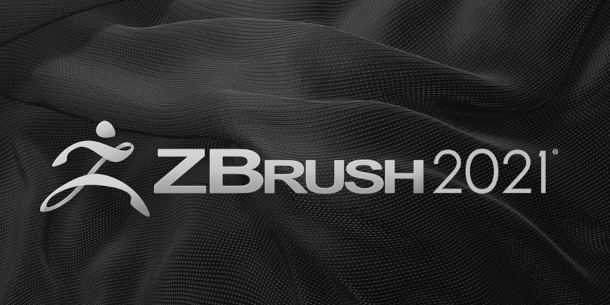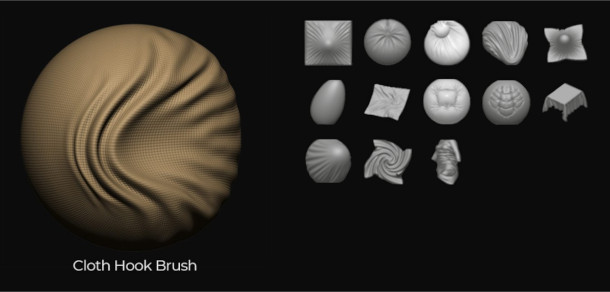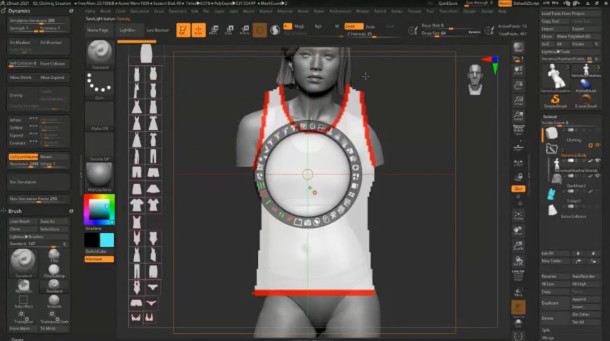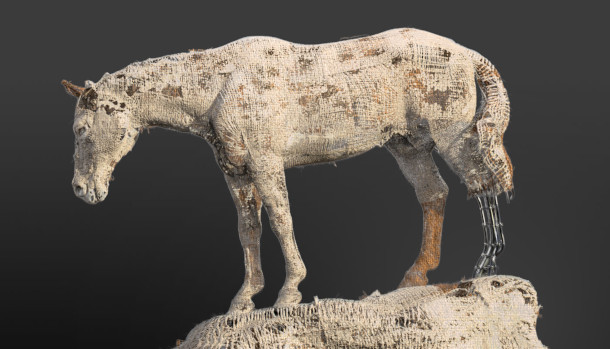Pixologic ships ZBrush 2021

Pixologic has released ZBrush 2021, a major update to the digital sculpting software.
The release adds a complete new dynamics toolset, primarily intended for creating cloth, but capable of a wide range of tasks, from set dressing to collision simulations.
Supporting features include a new Dynamic Thickness system for giving thickness to cloth; MicroPoly, a new system for generating weave structures; and a library of clothing pattern parts in SpotLight.
Other changes include new features in ZModeler intended to help with retopologising hi-res meshes, some nice updates to NanoMesh, and support for the Alembic and Collada file formats.
The new features were shown off during a livestream yesterday, the recording of which is embedded below.
As with all recent updates to ZBrush, the release is available free to all registered users of the software.
A complete new dynamics toolset for anything from creating cloth to collision simulation
By far the most significant feature in ZBrush 2021 is the new Dynamics palette, which enables users to run physics simulations on objects within a ZBrush scene.
When Pixologic posted its first sneak peek video of ZBrush 2021 last month, we – like most ZBrush users – focused on its potential for sculpting cloth.
That’s certainly part of its appeal, but it’s capable of a much wider range of tasks, from dressing a scene to adding collision damange to hard-surface models.
“Cloth is totally cool, but [Dynamics] does so many other things,” commented games artist and ZBrush educator Michael Pavlovich during the livestream. “The first six demos I did had nothing to do with cloth.”
Set up soft body dynamics through a set of simple control parameters
The Dynamics palette provides artists with two basic options: to Liquify the SubTools selected – an effect similar to deflating a balloon – or to apply Gravity to them.
The latter pulls objects towards the bottom of the screen – so by rotating the view, it’s possible to choose any direction relative to a scene – with a force determined by a Gravity Strength setting.
Any SubTool or combination of SubTools within a scene can be converted into collision geometry, meaning that other objects will deform around them on contact.
The effect can be controlled by a simple set of parameters: Simulation Iterations, Strength and Firmness, which determines the resistance of the object to deformation.
It’s also possible to Inflate geometry, which moves surfaces outwards in their normal directions, or to Deflate it, which does the reverse.

A set of over 10 new cloth brushes to refine cloth simulations
The most obvious use case for the Dynamics toolset is for cloth simulation: the livestream featured demos ranging from creating a cushion and a bedspread to generating clothing for a character.
Rather than sculpting cloth purely by hand, users can use simulation to get 90% of the way there, then refine the results manually using a new set of cloth sculpting brushes.
When we saw it in the original sneak peek, we described the functionality as resembling the new physics-enabled Cloth Brush introduced in Blender 2.83 earlier this year.
That’s true to a point, but ZBrush’s toolset is much deeper, with over 10 new new cloth sculpting brushes.
They range from basic manipulation tools like ClothMove, ClothPull and ClothSlide to ClothDimple, ClothTwister and ClothHook, which pull cloth objects into rolls and folds.
All of the new brushes come with with the same controls as standard sculpting brushes, so their effect can be adjusted with modifiers, by applying jitter or noise, or by changing the trail settings.
In addition, even non-cloth brushes respect the simulation: for example, building up the surface of a cloth object with the Standard brush causes wrinkles to form around the bulge.
However, one of the most versatile cloth manipulation tools is not a sculpting brush, but a Transpose tool.
Uses of TransposeCloth from scaling cloth along one axis to generate compression folds to colliding one object into others manually to deform its surface – about which, more later.

New alphas for clothing parts in SpotLight
The cloth simulation and cloth sculpting tools are also supported by a new set of alphas for clothing parts in SpotLight, ZBrush’s projection texturing system.
Each mimics the silhouette of a common item of clothing: underwear, pants, dresses, swimsuits, and so on.
When converted to geometry with Snapshot3D, they form the front and back panels of a 3D garment that can be connected automatically with a user-determined number of divisions.
The resulting garment can then be conformed around a character model using the Contract control in the Dynamics palette and finessed using the cloth sculpting tools.
It isn’t quite a complete pattern-based clothing design system like those provided by specialist tools like Marvelous Designer, but it’s surprisingly close.
For creating believable clothing for a character sculpt, it’s probably all you need.
Dent and crumple hard-surface models with inelastic collisions
As well as clothing, the Dynamics toolset can be used for inelastic collision effects.
One demo from the livestream showed the use of the TransposeCloth tool to run a 3D truck into a tree, denting first the hood, then the roof, and then colliding it with the ground plane to deflate the tyres.
Another showed the same effect recreated automatically, by setting gravity to act horizontally in the scene, then letting the simulation run its course.
The deformations generated can be transposed to a separate mesh layer, making it possible to blend between the crumpled and original uncrumpled states.
It’s also possible to record the animation and play it back within ZBrush, or export it in .mdd format to other DCC applications that support the format, like Houdini or LightWave.

New MicroPoly system recreates the weave structures of real fabrics
Other new features that play nicely with cloth simulation include MicroPoly, a new dynamic subdivision feature that can replicate the weave structures of real fabrics.
It replaces every face on a surface with tiled geometric units, making it possible to create effects ranging from cloth to chainmail.
In the livestream demos, it looked best suited to creating coarse weave structures, but you can change the resolution, or nest the effect to generate threads within larger fibres.
MicroPoly meshes can also be Polypainted, making it possible to generate subtle variations in colour across the surface of the cloth.
Dynamic Thickness converts single-sided meshes into solid cloth objects
Another key change supporting cloth workflows is the new Dynamic Thickness system, which converts single-sided meshes into geometry with separate front and back faces.
All of the features can be used together: one demo showed MicroPoly being applied to a plane to create a checkered quilt which was allowed to drape itself over a 3D bed under the influence of gravity.
Once settled, the quilt was pulled into wrinkles with the ClothHook brush, given dynamic thickness, then inflated to selectively puff up the inner parts of the checks.
Pixologic describes the toolsets as providing “a lot of potential for happy accidents.”
Updates to NanoMesh improve instancing workflows
However, ZBrush 2021 isn’t solely about dynamics. Other changes include an update to the NanoMesh instancing system, intended to make it possible to work with much larger instanced geometry.
Users can append single-poly planes to the surface of a model, to which NanoMesh geometry is applied.
A split screen display shows the source mesh side by side with the entire model, with changes made to the source propagating to the instances on its surface in real time.
One demo from the livestream showed the new NanoMesh Edit Mesh feature in use to simultaneously sculpt shoulder pads, elbow pads and knee pads for a character.
Changes to ZModeler help with retpologising high-resolution sculpts
ZModeler, ZBrush’s polygonal modelling toolset, gets new features to help retopologise high-res sculpts.
Users can create low-poly all-quad geometry across the surface of a sculpt, using the new Extrude action to draw out a new polygon from the edge of an existing one, and having it snap to the underlying model.
A new Edge > Inset > Equidistant option preserves the curvature of a low-res mesh when insetting new edges within it. You can find a full list of new ZModeler features here.
Support for new 3D file formats, workflow changes, and performance improvements
Other changes in ZBrush 2021 include support for the iMage3D system introduced in ZBrushCoreMini, the new free entry-level edition of the software.
Users can save a GIF or PNG image of a model that contains the information necessary for ZBrush to recreate the original mesh, making it easier to share 3D models on social media.
Images generated in ZBrushCoreMini can be opened in ZBrush itself, but not vice versa.
The update also makes it possible to import export files in the Alembic or Collada format, or in 3MF format, a new open-source format for exporting 3D models for additive printing.
There are also a number of quality of life improvements: as well as those listed in the online documentation, one nice change shown in the livestream is the option to hold [Alt] to ‘unpaint’ a polygon from a Polygroup.
In addition, performance has been improved, particularly when using the Move brush or DynaMesh.
Pixologic doesn’t put any figures on the speed boost, but you can see a side-by-side performance comparison between ZBrush 2020 and ZBrush 2021 at 01:50 in the original sneak peek video.
Pricing and system requirements
ZBrush 2021 is available for 64-bit Windows Vista+ and Mac OS X 10.10+.
New perpetual licences cost $895 and subscriptions cost $39.95/month or $179.95 for six months. ZBrush 2021 is, yet again, a free update for registered users of any version of the software.
Read an overview of the new features in ZBrush 2021 on Pixologic’s website
Read a full list of new features in ZBrush 2021 in the online documentation
